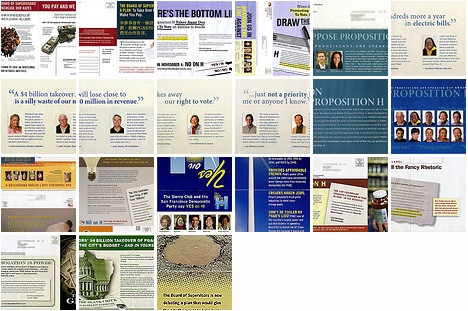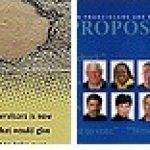See our growing collection of San Francisco election fliers for and against Proposition H at our Flickr site.
Proposition H is described as a clean energy measure by its proponents, and a “blank check” by its opponents.
With an eye-popping $5.4 million spent on the No on H side compared to the $19,000 on the other, Proposition H merits a close look from voters.
Those are dollars spent through September. Expect more money to flow in these next few weeks, as the opposing forces battle over the definitions, costs and consequences of the measure.
Five-Point Proposal
Framers of Proposition H say the overall goal of this five-pronged proposal is for San Francisco to show strong leadership in reducing greenhouse gases and electric bills for San Franciscans.
- It starts with a feasibility study to evaluate the best way to provide “clean, secure, cost effective electricity” for all in the city, including the possibility of “municipalization” — that is, the city becoming the primary electric-power provider for residents and businesses. This is something 2,000 municipalities, from Palo Alto to Long Island, New York, currently do. The outcome of the study could also mean that the city could eventually replace Pacific Gas & Electric for San Francisco’s more than 370,000 customers.
- It mandates deadlines for using clean, renewable energy sources by 2050.
- It establishes an Office of the Independent Ratepayer Advocate to recommend rates to the city’s Public Utilities Commission.
- It provides that any PG&E employees who might become city employees suffer no loss of seniority, compensation or benefits.
- The most contentious part of the measure is that it amends the city charter to give the city, through the Board of Supervisors, the authority to issue revenue bonds to acquire, install or construct “other public utility facilities” — what critics call the “blank check.”
Some observers think such a high-profile loss would encourage the departure of other municipalities from PG&E’s 70,000-square-mile territory, ranging from Eureka to Bakersfield.
That, of course, explains PG&E’s interest in fighting the measure. The high stakes and big money have brought a veritable flood of “No on H” mailers into San Francisco mailboxes.
Long History
Proposition H is the latest manifestation of a long history of pitched battles between PG&E and proponents of publicly owned electric power.
Through the Raker Act of 1913, Congress gave San Francisco the right to dam the Tuolumne River in Yosemite National Park to provide water and hydroelectric power for the public good.
Yet the city never took up the opportunity, and nearly a dozen attempts at the ballot have not succeeded in forcing the issue.
San Francisco, however, is not a newcomer in the public-utility business.
The city already operates water service for its residents and many communities from the Hetch Hetchy Reservoir, and provides its own electric service to power Muni, the Board of Education facilities, half the city’s street lights, the San Francisco International Airport and the port.
To date, though, electric power to residents and businesses is provided by PG&E.
Bond ‘Exceptions’ and the Blank Check
The 2008 ballot measure is different from its predecessors, because it mandates that San Francisco actively reduce greenhouse gases in a series of mandated deadlines ending in 2040.*
Voters paved the way for this in 2001 by authorizing the Board of Supervisors to issue revenue bonds for renewable energy projects in the future without going back to the ballot for approval of a dollar amount.
Revenue bonds, however, still require the mayor and the controller to sign off on what the supervisors propose.
Voters have previously authorized supervisors to issue such bonds seven other times, creating “exceptions” in the city’s charter for airport and port projects, building affordable housing, and repairing existing water and electric power facilities.
Where the controversy arises is that Proposition H’s provisions would add language to the 2001 renewable energy authorization, allowing supervisors to issue revenue bonds to acquire or build “other utility facilities.”
Opponents contend this phrasing would give supervisors the ability to overreach, with broad powers to issue revenue bonds for the takeover of any utility, at any price.
Drafters say they need this language to cover facilities such as transmission lines that were not included in the 2001 proposal.
The phrase “other utility facilities” would exclude utilities such as Comcast, the local cable TV provider, because it’s part of the revenue bond exception dealing with renewable energy, said Rick Galbreath, an aide to Supervisor Ross Mirkarimi who worked on drafting of the measure.
Questions About Price Tag, Rate Increase
Under the name of San Francisco Clean Energy, proponents have raised $25,000 (mostly through small donations ranging from $100 to $500), a smattering of $1,000 donations from companies and individuals, and $10,000 from businessman Clint Reilly, a former mayoral candidate and campaign consultant.
Although election mailers from the “Committee to Stop the Blank Check, No on H” are filled with names of people and organizations opposed to the measure, the virtual sole contributor of the $5.4 million raised by the campaign is PG&E.
The only exception is a single $100 donation from Michael Hardeman, listed as business representative of the International Union of Painters & Allied Trades District Council 36.
This money is paying for the current television ads that raise the specter of supervisors wielding “a blank check” to issue revenue bonds — but that fail to acknowledge the veto power retained by the mayor and city controller.
The “No” campaign ads contend it would cost $4 billion acquire PG&E’s assets.
The estimate is based on figures supplied by PG&E, and includes the original cost of all its assets — transmission lines, rolling stock, all its buildings, such as its 18-story Beaux Arts headquarters on Market Street — as well depreciation and severance pay, said Stephanie Bjornson, communications director of the No on H campaign.
It’s somewhat premature for dependable figures, however.
As public acquisitions of utility facilities usually go, the final price would be dependent on what, specifically, the city might choose to purchase, and the negotiations flow from there, said Ursula Schryver, director of customer service for the American Public Power Association, a nonprofit service organization for 2,000 community-owned electric utilities.
As with any negotiation — from a home purchase to a used car sale — a seller, especially an unwilling one, usually names the highest price. About 40 municipalities have converted to public power in the past 10 years, and some of those actions end up in court, she said.
Rates for customers usually — but not always — go down, Schryver said.
In San Francisco, the city controller does not provide hard numbers for the cost of Proposition H, observing that different approaches could be taken in the study, and estimates only that the proposal could possibly cost “billions.”
Since there is no study yet, the only figures being cited are those that PG&E has supplied.
No on H campaign ads also assert that each customer, on average, would have to pay $400 more per year for 30 years, a figure supplied by PG&E, as well.
However, without a feasibility study, it’s unknown whether rates would go up, down or stay the same — and rejecting Proposition H doesn’t guarantee rates won’t rise, anyway.
In fact, PG&E raised its rates by 6 percent on Oct. 1 to cover the cost of natural gas increases, and may raise rates again in January 2009.
Unflattering Portraits
Proposition H proponents have been driving home two points: the optimism that renewable, clean energy is attainable (with vivid footage of the destructiveness of nature they link to global warming) and images of energy generation via wind, sun and water.
And they’ve distributed another ad on their Web site and via YouTube characterizing PG&E executives as stereotypical profiteers, walking through San Francisco from downtown to Folsom Street to Crissy Field to Potrero Hill, vulgarly pointing out the San Franciscans they’re going to screw, just the way fat cats on Wall Street prospered at the expense of others.
It’s an attention-getting, even as it feeds into our baser instincts.
But it doesn’t attempt to counter the basic arguments of its detractors.
L.A. Chung is an independent journalist with 28 years of experience in newspapers. She has been an editor and columnist at the San Jose Mercury News. In a prior life, she covered San Francisco City Hall for the San Francisco Chronicle, during the Frank Jordan and Art Agnos administrations.
This story corrects a previous version that said the measure would mandate the city reduce greenhouse gases by running a public power agency.
The San Francisco 2008 Election Truthiness Report is co-produced by Newsdesk.org and The Public Press, and funded through small donations using the Spot.Us "crowdfunding" Web site. Tune in Crosscurrents on KALW (91.7 FM San Francisco or crossurrentsradio.org) on Oct. 20 at 5:00 p.m. for an in-depth look at Proposition H.









